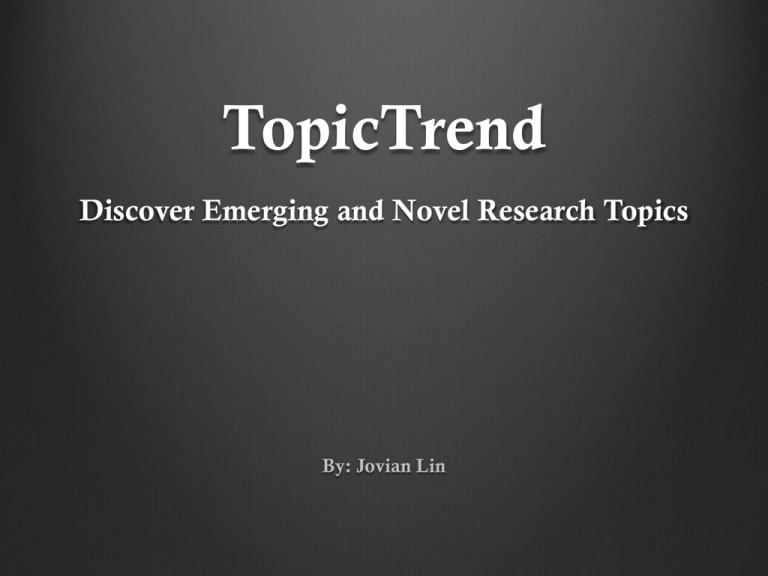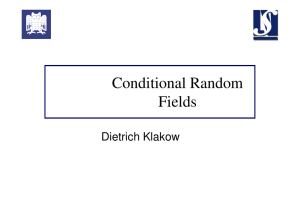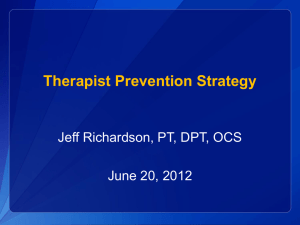Slides - Jovian Lin
advertisement

TopicTrend Discover Emerging and Novel Research Topics By: Jovian Lin Introduction Formulating a research idea is the 1st step for success in academia. A worthy research idea must be original and innovative. In order to come up with innovative research ideas, researchers have to read a lot of published articles… … which is time-consuming. “Is there any shortcut to success?” “No.” “There are efficient ways to achieve success” Search Engines in Digital Libraries: Introduction Search engines support information seeking and retrieval. List of titles (of articles) “Search Query” Search Engine Search Results How useful is this result to the Introduction junior researcher? Search engines support information seeking and retrieval. However, is this enough for the junior researcher? FYP students • • • • 1st year PhD students Define a research topic (from zero knowledge) Help in survey Identify emerging/new research areas to explore Determine related topics Problem Definition Junior researchers want: Understand research topics and trends. Recognize HOT topics. Understand how topics interact and influence research activity. Problem Definition Junior researchers want: Understand research topics and trends. Recognize HOT topics. Understand how topics interact and influence research activity. Current Inefficient Method Enter a search query Extract new terms from selected article Select a few articles to read View results Search Results Information overload ! Problem Definition Junior researchers want: Understand research topics and trends. Recognize HOT topics. Understand how topics interact and influence research activity. Current Inefficient Method Enter a search query Extract new terms from selected article Select a few articles to read View results Problem Definition Junior researchers want: Understand research topics and trends. Recognize HOT topics. Understand how topics interact and influence research activity. Desired Efficient Method Enter a search query View results TopicTrend Do it quick! List of HOT research topics (related to the search query) Visualization of the research topics Quick Demo Evaluation Recruited 4 participants. • • • • Chemistry / PhD Engineering (Transportation) / PhD Comp Science (AI) / PhD Engineering / FYP Participants: Tested TopicTrend using queries from their respective domains. Rated TopicTrend’s output (w.r.t. their query). [Quantitative] Filled up a questionnaire. [Qualitative] Evaluation “machine learning” Topic H Topic I Topic G Topic J Topic F Topic A Topic B Topic A 1 Topic B 0 Topic C 1 Topic D 1 Topic E 1 Topic F 1 Topic G 1 Topic H 1 Topic I 1 Topic J 1 Topic E Score Topic C Topic D 9/10 Quantitative Evaluation Average score = 68.125% Qualitative Evaluation Questionaire using Five-Point Likert Scale. 1=Disagree, 5 =Agree. Some examples: “The system was easy to use.” 4.75 / 5 “The system gave interesting results.” 4 / 5 “I was able to get a better understanding of the topics.” 4 / 5 “I was able to discover trends.” 4 / 5 “I was able to discover relationships between topics.” 4 / 5 “I was able to discover potential, novel topics.” 4 / 5 Details in Project Report. Conclusion TopicTrend is a visualization tool that helps junior researchers: Understand research topics and trends. Recognize HOT topics. Understand how topics interact and influence research activity. However, results were mediocre Due to presence of stop phrases (e.g., “problem set”, “proposed model”, etc) Solutions and Future Work: TF-IDF weight — don’t have to manually enter stop words. Statistical measure to evaluate how important a word is. The importance increases to the number of times a word appears in the document... But is offset by the frequency of the word in the corpus. Latent Dirichlet Allocation (LDA) – view each abstract as a mixture of topics. (David Blei) Online LDA – find topics faster than normal LDA; analyze in a stream. Dynamic Topic Models (DTM) – captures the word evolution of each topic over time. Search by exemplar (instead of search by keyword) Benefits users who have difficulty expressing their query. Conclusion TopicTrend is a visualization tool that helps junior researchers: Understand research topics and trends. Recognize HOT topics. Understand how topics interact and influence research activity. However, results were mediocre Due to presence of stop phrases (e.g., “problem set”, “proposed model”, etc) Solutions and Future Work: TF-IDF weight — don’t have to manually enter stop words. Statistical measure to evaluate how important a word is. The importance increases to the number of times a word appears in the document... But is offset by the frequency of the word in the corpus. Latent Dirichlet Allocation (LDA) – view each abstract as a mixture of topics. (David Blei) Online LDA – find topics faster than normal LDA; analyze in a stream. Dynamic Topic Models (DTM) – captures the word evolution of each topic over time. Search by exemplar (instead of search by keyword) Benefits users who have difficulty expressing their query. Thank You Backup Slides Implementation OpenNLP — a machine learning based toolkit for the processing of natural language text. Used OpenNLP to retrieve a list of NPs. NP A OpenNLP Tools An article NP B NP C NP D NP E NP F 1. 2. 3. 4. Sentence Detection Tokenization Part-of-Speech (POS) Tagging Chunking and Retrieving NPs Implementation Sentence Detection Pierre Vinken, 61 years old, will join the board as a nonexecutive director Nov. 29. Mr. Vinken is chairman of Elsevier N.V., the Dutch publishing group. Rudolph Agnew, 55 years old and former chairman of Consolidated Gold Fields PLC, was named a director of this British industrial conglomerate. Those contraction-less sentences don't have boundary/odd cases...this one does. • Pierre Vinken, 61 years old, will join the board as a nonexecutive director Nov. 29. • Mr. Vinken is chairman of Elsevier N.V., the Dutch publishing group. • Rudolph Agnew, 55 years old and former chairman of Consolidated Gold Fields PLC, was named a director of this British industrial conglomerate. • Those contraction-less sentences don't have boundary/odd cases...this one does. Implementation Tokenization • Pierre Vinken, 61 years old, will join the board as a nonexecutive director Nov. 29. • Mr. Vinken is chairman of Elsevier N.V., the Dutch publishing group. • [Pierre] [Vinken] [,] [61] [years] [old] [,] [will] [join] [the] [board] [as] [a] [nonexecutive] [director] [Nov.] [29] [.] • [Mr.] [Vinken] [is] [chairman] [of] [Elsevier] [N.V.] [,] [the] [Dutch] [publishing] [group] [.] Implementation Part-of-Speech Tagging • Pierre Vinken, 61 years old, will join the board as a nonexecutive director Nov. 29. • Mr. Vinken is chairman of Elsevier N.V., the Dutch publishing group. • [NNP] [NNP] [,] [CD] [NNS] [JJ] [,] [MD] [VB] [DT] [NN] [IN] [DT] [JJ] [NN] [NNP] [CD] [.] • [NNP] [NNP] [VBZ] [NN] [IN] [NNP] [NNP] [,] [DT] [JJ] [NN] [NN] [.] Implementation Text Chunking and Extracting NPs Text chunking consists of dividing a text in syntactically correlated parts of words. Uses the Tokenization and POS Tagging data. For example: He reckons the current account deficit will narrow to only # 1.8 billion in September. Becomes: [NP He ] [VP reckons ] [NP the current account deficit ] [VP will narrow ] [PP to ] [NP only # 1.8 billion ] [PP in ] [NP September ] . Implementation Text Chunking and Extracting NPs Text chunking consists of dividing a text in syntactically correlated parts of words. Uses the Tokenization and POS Tagging data. Note the: • B-Chunk • I-Chunk Implementation OpenNLP — a machine learning based toolkit for the processing of natural language text. Used OpenNLP to retrieve a list of NPs. NP A OpenNLP Tools An article NP B NP C NP D NP E NP F 1. 2. 3. 4. Sentence Detection Tokenization Part-of-Speech (POS) Tagging Chunking and Retrieving NPs Implementation An algorithm to calculate the score of a NP. # (0 ~ 2 years) 10 NP A # (2 ~ 4 years) 2 NP B # (4 yrs & beyond) 1 Score = = NP C 10 + 1 10 + 2 + 1 + 20 11 33 NP D NP E # (0 ~ 2 years) 1 NP F # (2 ~ 4 years) 2 # (4 yrs & beyond) 10 Score = = = 0.333 1+1 1 + 2 + 10 + 20 3 33 = 0.090 Implementation An algorithm to calculate the score of a NP. NP A NP B NP C NP D NP E NP F Implementation Re-rank the list of NPs base on the score. NP A NP B NP B Re-rank NP D NP C NP E NP D NP C NP E NP A NP F NP F Implementation Calculate the relationship strength between NPs by considering the common articles (PIIs) that they have. The more articles they have in common, the thicker the edge. The End






